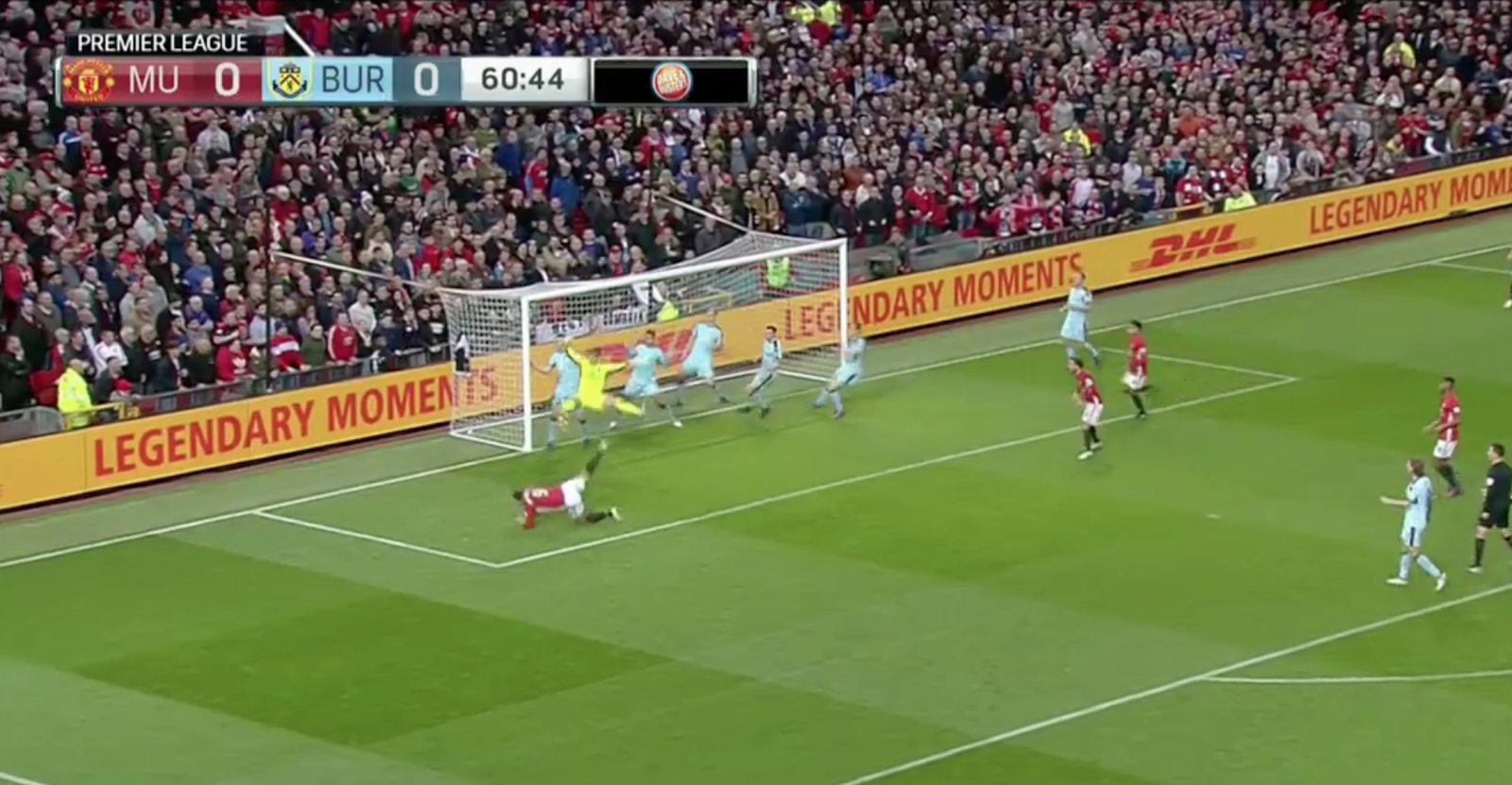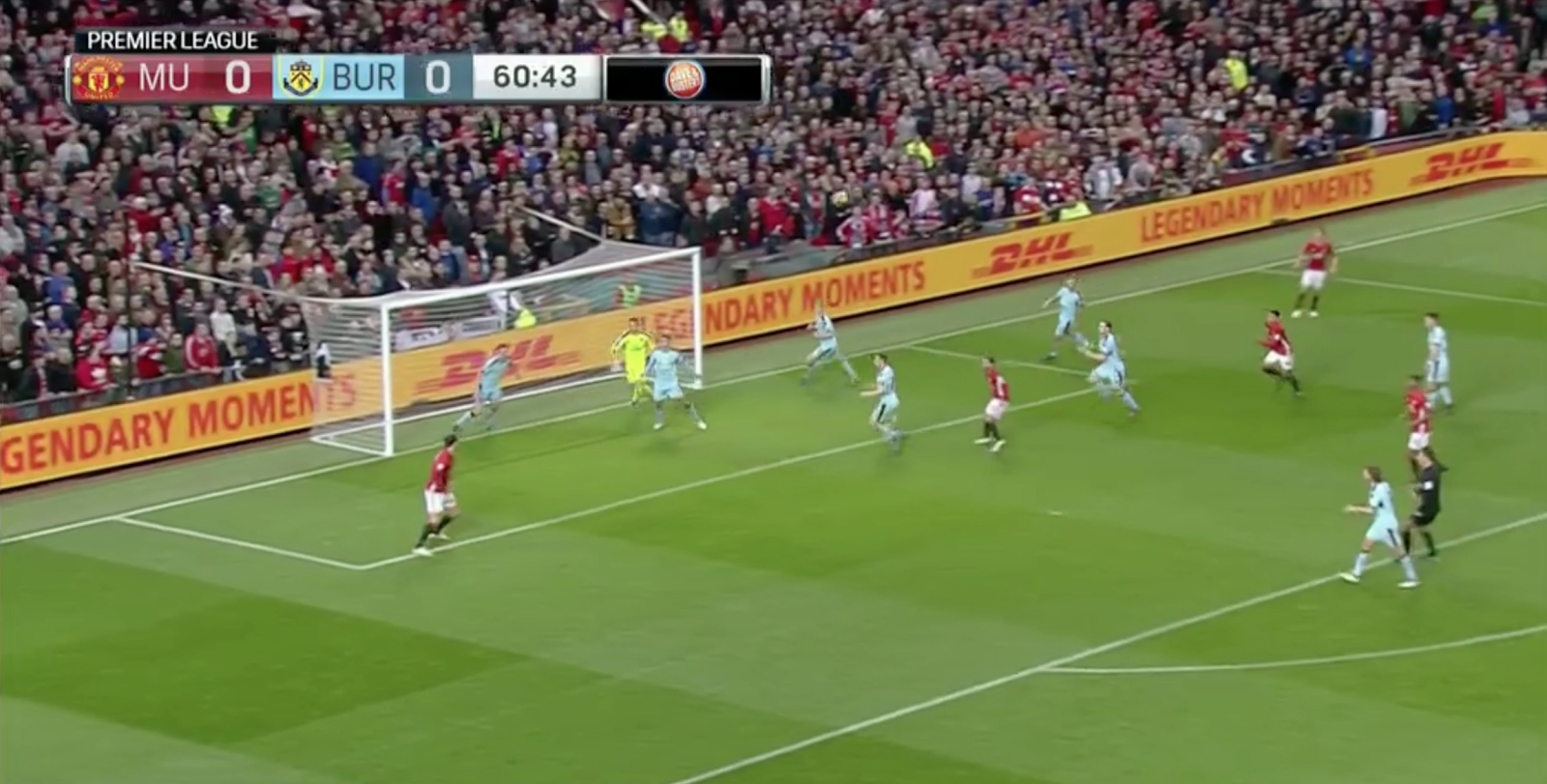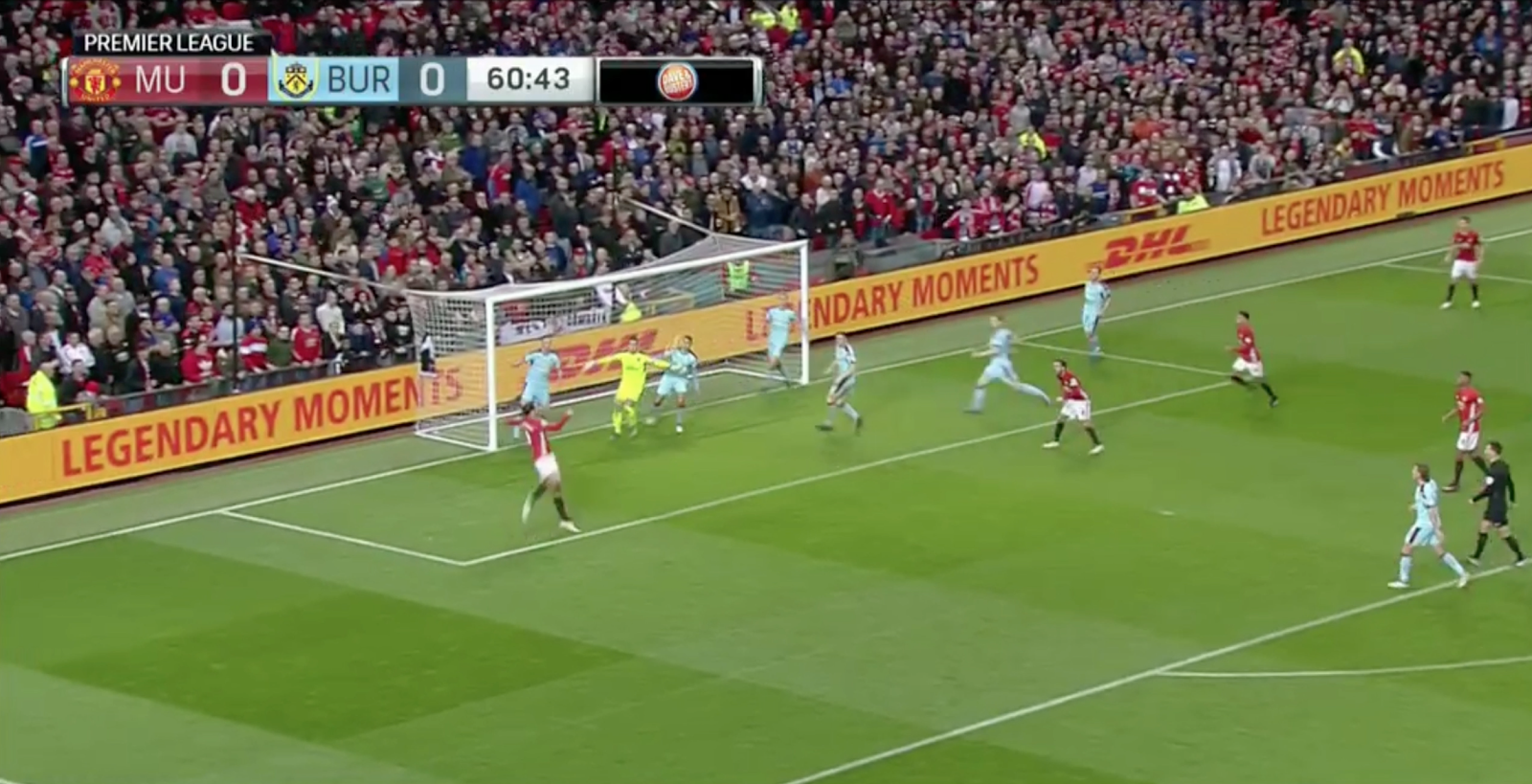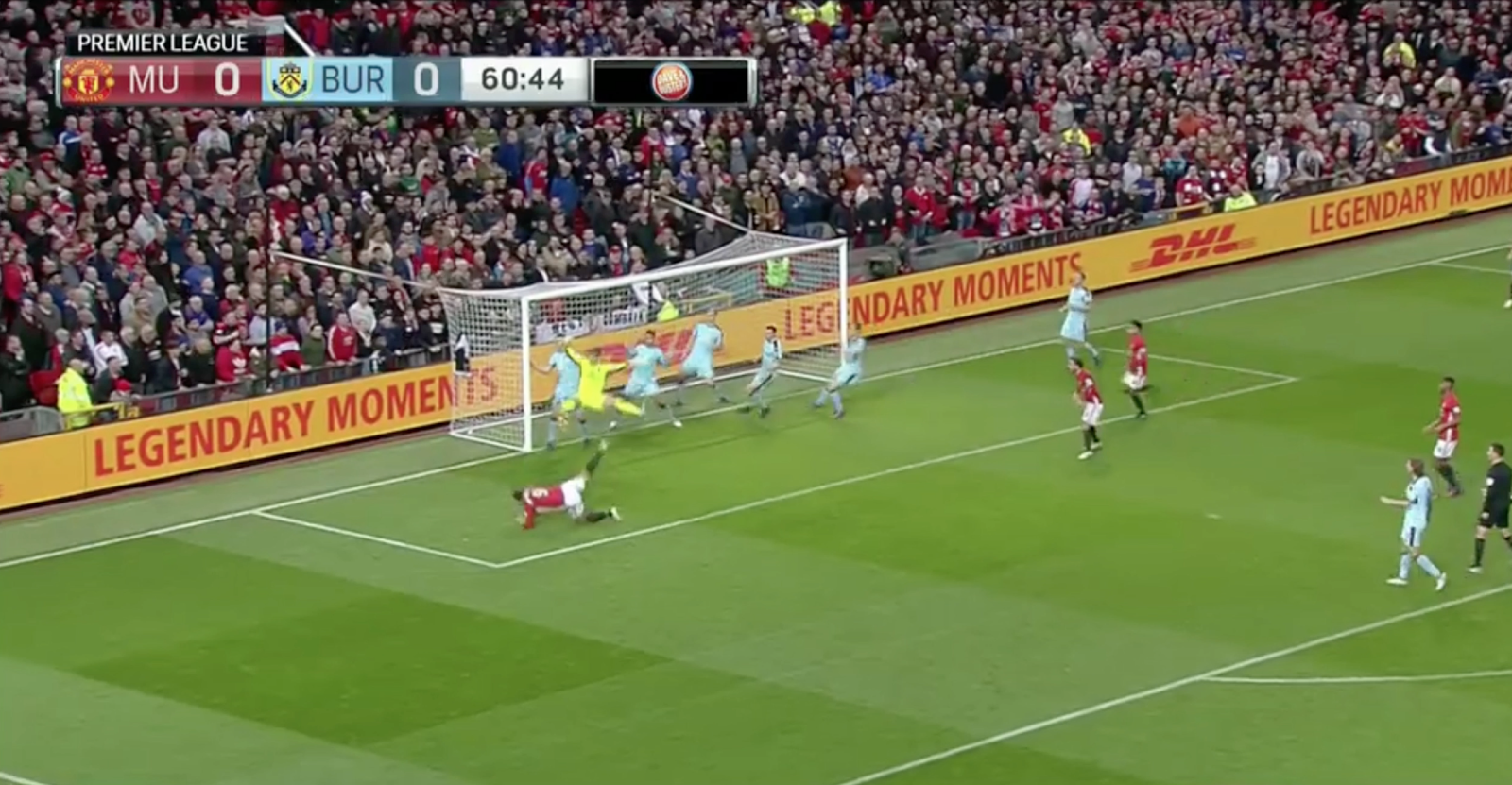Tom Heaton relied on a goalkeeper’s instincts to deny Zlatan Ibrahimovic in the 61st minute of Burnley’s latest match
Imagine a soccer game in which one team had 72% ball possession, 19 corner kicks, 39 shots, and 11 shots on goal. How do you think that game would end? In all likelihood, you’d predict that the team with those stats would have comfortably won the game — and in the overwhelming majority of cases, you’d be correct.
But that was the box score for Manchester United’s match against Burnley on Saturday, which ended in a scoreless draw. That outcome had a lot to do with the stellar play of Burnley and England National Team goalkeeper Tom Heaton, who made 11 saves on the day.
None of his interventions were more breathtaking than Heaton’s sprawling save to deny Zlatan Ibrahimovic from close range in the 61st minute. United was attacking in Burnley’s final third. Ander Herrera made an errant pass but quickly managed to win the ball back. He immediately attacked Burnley’s end line. Once he was in space, he briefly lifted his head to locate Zlatan Ibrahimovic at the back post and played a beautiful chip across the goalmouth. Zlatan was unmarked and wound up for an impressive scissor kick. He managed to get solid contact on the ball and it looked like a certain goal until Tom Heaton spread himself out into a Schmeichel-esque ‘star jump’ to palm the ball away.
https://www.youtube.com/watch?v=ks9M6w4qTfo
I want to go back to the beginning of the play and explain how Heaton saved Burnley’s day. As Herrera regained possession, Heaton was at the near post. That is the correct position in such situations because Herrera was inside Burnley’s box and approaching the end line. Heaton took this position in order to be set for a shot or to cut off a low, whipped-in pass to an onrushing attacker at the near post . In the frame below, you can see that Juan Mata has a chance to run into the space at the near post for a shot on goal:
The moment Hererra decided to chip the ball, Heaton’s mentality changed. He now knew that Mata wouldn’t be receiving the ball and that it was headed for the back post. Heaton first step took a drop step and then turned into a crossover step in order to cross the goal-mouth as fast as he could.
https://www.whatahowler.com/the-play-podcast-a85e5e47ade6
As a young goalkeeper you are taught two types of ways to travel across the goal-mouth: the side shuffle and the crossover step. The side shuffle is used when you have to cover smaller spaces quickly or when you have more time to move across your goal in order to get in position and set for a shot. Alternatively, the crossover step is used when you need to traverse longer distances as quickly as possible. Therefore, in this situation — a cross chipped towards the back post — the crossover step was Heaton’s best option.
Heaton was only going to have a chance to make this save if he got the footwork right. Quick feet and proper footwork are a stable foundation for every goalkeeper: That’s how a keeper gets from point A to point B. If Heaton had elected to side shuffle instead of using the crossover step, we most likely wouldn’t be talking about this save at all because he would have been unable to cover the necessary space. In the frame below you can see Heaton mid-stride in the crossover step:
As Heaton turned, he saw Zlatan squaring up for a shot on goal. Heaton now knew the ball’s final destination, so he rushed across his goal and made himself as big as possible to block the shot. You may have heard the goalkeeping term ‘keep yourself big’ before, and this is a perfect example of the phenomenon.
As a goalkeeper, you want to ‘keep yourself big’ — chest and head square with the ball, arms wide at your side, and feet shoulder-width apart — when closing down the attacker to cover more space and limit the angles that the striker can shoot past you. In order to make the save, it’s important to keep your frame as big as possible for as long as possible. If you shrink in these moments — chest and head turned away from the ball, arms close to your body, and feet extremely narrow — you reduce your chances of impacting the play because you’re letting the striker choose from a more favorable range of angles.
By the time Heaton reached the middle of the goal, he had already spread his arms out to his sides in anticipation of having to ‘keep himself big’ to make the save:
In this moment, Heaton is also aware that his teammates are covering the goal behind him due to vocal and visual cues. His defenders are most likely shouting “I’ve got the line” or “I’ve got the far post”. These forms of communication are essential in the relationship between the goalkeeper and the back line because they help the goalkeeper decide whether he can leave his goal and put pressure on the forward. This is something we work on at Helsingborg; the closest man to the ball in this type of situation — the striker is inside your own six-yard box — applies defensive pressure and the others show support and cover the goal-line. This applies to goalkeepers and defenders alike.
If Zlatan had received the ball further away from the goal — let’s say 12–15 yards — then it would have been Heaton’s job to stay closer to his goal-line, communicate with one of his defenders to put pressure on the striker, get his own angle correct, get set, and give himself more space — and therefore reaction time — to make the save.
In this instance, however, Heaton was the closest man to the attacker so it was his job to close him down. As Zlatan was about to make contact on his shot, Heaton timed his approach and stretcheded out as large as he could. He jumped and made a save reminiscent of one of United’s very own legends, Peter Schmeichel.
If you’re on or near the goal-line , as Heaton was here, and someone has a header or shot inside your own six-yard box, the chances of you reacting to where it goes are slim. You simply don’t have enough reaction time. This spread technique therefore helps you cover as much of the goal as possible. If Heaton had decided to come across the goal, get set, and tried to make a reaction save, we would likely be talking about a different scoreline today:
Heaton’s save was not the type of intervention goalkeepers train for with great frequency because it rarely comes up in matches. That being said, a goalkeeper’s main job is to keep the ball out of the back of their net, and sometimes reason and logic go out the window. In those moments, goalkeepers have to rely on the instincts they have honed from several years of game and training experience to make a save.






